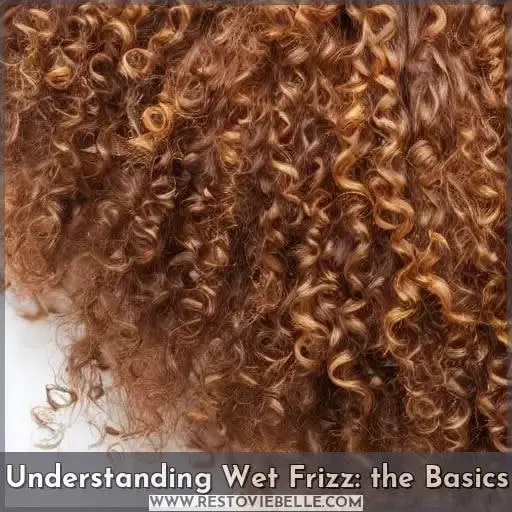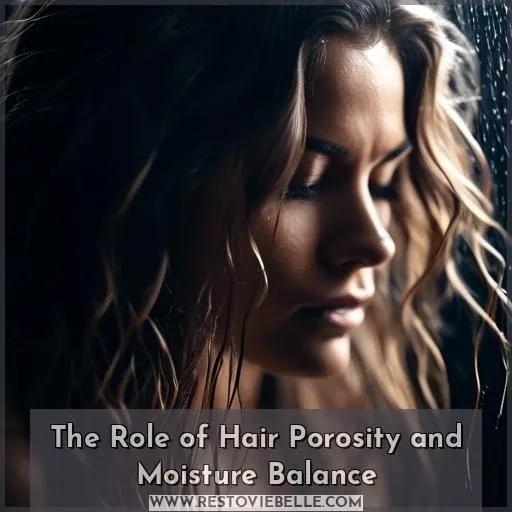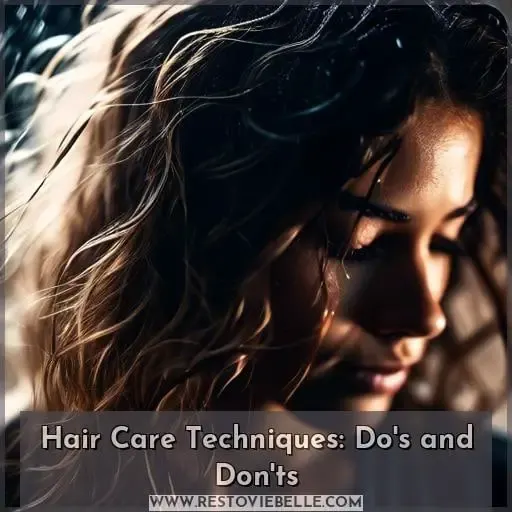This site is supported by our readers. We may earn a commission, at no cost to you, if you purchase through links.
 Struggling with wet frizz? You’re not alone. This common hair dilemma, marked by hydrogen bond disruption, moisture absorption, and hair porosity, can turn your locks from sleek to chaotic in no time.
Struggling with wet frizz? You’re not alone. This common hair dilemma, marked by hydrogen bond disruption, moisture absorption, and hair porosity, can turn your locks from sleek to chaotic in no time.
But fear not! This guide is your roadmap to understanding and conquering wet frizz. We’ll dive into the science of hair porosity and moisture balance, explore how humidity plays a villain, and arm you with hair care techniques and solutions.
Get ready to tame the frizz and unlock the secret to beautifully managed hair in 2024.
Table Of Contents
- Key Takeaways
- Understanding Wet Frizz: the Basics
- The Role of Hair Porosity and Moisture Balance
- Environmental Factors: Humidity and Its Effects
- Hair Care Techniques: Do’s and Don’ts
- Solutions and Preventative Measures
- Frequently Asked Questions (FAQs)
- Can certain haircuts or hairstyles contribute to wet frizz?
- How does one’s diet and overall health impact the likelihood of experiencing wet frizz?
- Are there any specific vitamins or supplements that can help reduce wet frizz?
- How does the water quality in one’s home, such as hard or soft water, affect wet frizz?
- Can hormonal changes, like those during pregnancy or menopause, influence the occurrence of wet frizz?
- Conclusion
Key Takeaways
- Hydrogen bond disruption due to moisture absorption, hair porosity, and environmental humidity are primary causes of wet frizz, making curly and wavy hair particularly vulnerable.
- Understanding and managing hair porosity is crucial for controlling frizz, with low porosity hair repelling moisture and high porosity hair absorbing it quickly, both leading to frizz.
- Environmental factors like humidity exacerbate wet frizz by causing hair to swell and absorb excess moisture, highlighting the importance of moisture balance and the use of anti-frizz products.
- Proper hair care techniques, including the use of anti-frizz serums, leave-in conditioners, and avoiding rough handling, are essential for minimizing wet frizz and maintaining healthy hair.
Understanding Wet Frizz: the Basics
Wet frizz can feel like your hair’s way of rebelling against your best efforts to look polished, especially when you’re stepping out with what you thought were perfectly styled curls or waves.
Imagine your hair as a sponge, soaking up moisture from the air, which sounds like a good thing until you realize it’s the main culprit behind your frizz. The structure of your hair, particularly if it’s curly or wavy, makes it a prime target for this unruly behavior.
When wet, your hair’s cuticles lift and absorb moisture, leading to swelling of the strands and, you guessed it, frizz. This is where hair porosity comes into play. Think of porosity as your hair’s thirst level; some hair types are parched, drinking up moisture and causing frizz, while others repel water, leading to a lack of definition and more frizz as they dry.
Moisture levels in your hair are like a seesaw; too much or too little can tip the balance, causing your hair to act out. So, when you’re battling wet frizz, you’re essentially playing a game of moisture balance, trying to keep your hair’s thirst quenched just right to prevent it from puffing up or falling flat.
The Role of Hair Porosity and Moisture Balance
Moving on from the basics of wet frizz, let’s dive into the nitty-gritty of hair porosity and moisture balance.
Ever wondered why some folks can step out in misty weather looking like a shampoo ad, while your hair poofs up like a dandelion? It’s all about porosity levels and moisture retention.
Imagine your hair as a sponge. Some sponges soak up and hold water like a champ, while others let it slip right through.
Low porosity hair is like that sponge that repels water. It’s tough for moisture to get in, but once it’s there, it’s not going anywhere. On the flip side, high porosity hair absorbs moisture faster than a gossip spreads in a small town but holds onto it about as well as a sieve holds water.
And then there’s the Goldilocks zone – medium porosity hair, which strikes a balance between absorbing and retaining moisture. So, whether you’re dealing with a frizz ball or limp locks, understanding your hair’s porosity is key to mastering moisture and saying goodbye to bad hair days.
Environmental Factors: Humidity and Its Effects
Humidity-induced frizz is a common challenge, especially when moisture in the air disrupts the hydrogen bonds in your hair, leading to unwanted frizz and flatness.
If your hair is highly porous, it absorbs more moisture, which can cause your strands to swell and the cuticles to lift, making your hair appear frizzy and unruly.
To combat this, maintaining a balance between hydration and preventing your hair from becoming too flat is crucial, especially in humid conditions.
Humidity-Induced Frizz
Humidity’s like that uninvited guest at your hair party, turning sleek to freak in no time.
When the air’s thick with moisture, your hair acts like a sponge, soaking up humidity and puffing up with frizz. It’s all about those hydrogen bonds in your hair getting cozy with water molecules, leading to a not-so-hot hair day.
But fear not! A little know-how on product recommendations, home remedies, and the magic of natural oils can be your secret weapon. Think of hair masks and scalp treatments as your hair’s best friends, keeping things smooth and under control.
So, before you step out, arm your locks with some frizz-fighting armor and keep that mane tame!
Moisture Absorption Effects
When you step out on a muggy day, your hair acts like a sponge, soaking up the moisture, which can lead to a frizz fest.
High humidity can turn your hair into a rebellious mess, as it absorbs moisture and swells, disrupting your sleek style.
If your hair has high porosity, it’s like an open door, letting moisture rush in and out, leading to a battle between hydration and hair shaft damage.
To keep your locks from ballooning, you’ll want to focus on moisture retention and shield your hair with products that boast hydrophobic properties to fend off the humidity variation assault.
Hydration vs. Flatness
Continuing from the effects of moisture absorption, let’s dive into the balancing act of hydration vs.
You know the drill: too much moisture, and your hair throws a fit, lying limp and lifeless like a deflated soufflé. But get it just right, and you’re in for a good hair day. It’s all about moisture balance.
If your hair’s porosity is high, it’s like a sponge, soaking up humidity and puffing up like a poodle. On the flip side, low porosity hair can be as stubborn as a cat at bath time, repelling moisture and staying too dry.
Aim for that sweet spot where your hair is hydrated without being overwhelmed, keeping it bouncy and frizz-free.
Hair Care Techniques: Do’s and Don’ts
Navigating the stormy seas of hair care, especially when battling wet frizz, can feel like trying to tame a wild beast. But fear not! With the right tools and techniques, you can become the master of your mane.
First off, let’s talk about your arsenal. Anti-frizz serums and leave-in conditioners are your best friends, acting as your hair’s personal bodyguards against humidity’s unruly effects. Think of them as the cape and shield for your superhero hair, providing protection and hydration without weighing it down.
Now, onto the art of detangling. Using detangling brushes can make a world of difference, transforming a potential tug-of-war into a smooth glide through your locks. These brushes are like diplomats, negotiating peace between tangled strands with minimal fuss.
When it comes to styling, mastering blow-drying techniques can elevate your hair game to new heights. It’s not just about blasting your hair with hot air; it’s a strategic operation. Imagine you’re sculpting your hair, where patience and the right tools can turn a frizzy mess into a masterpiece.
Deep conditioning is the secret sauce to keeping your hair in tip-top shape. It’s like a spa day for your strands, offering deep nourishment and helping to maintain that crucial moisture balance.
Solutions and Preventative Measures
To keep your mane in check and avoid the dreaded wet frizz, consider these savvy strategies:
-
Choose the Right Products: Arm yourself with anti-frizz serums and hair masks designed to fight the frizz. Look for ingredients that seal in moisture without weighing down your hair. Remember, it’s not just about slapping on any product; it’s about finding your hair’s best ally in the battle against unruliness.
-
Mind Your Styling Techniques: When you’re styling, use heat protectants to shield your locks from thermal damage. And here’s a pro tip: if you’re blow-drying, aim the nozzle downward to smooth the cuticle, which helps to lock out excess moisture and keep frizz at bay.
-
Embrace Leave-in Conditioners: These are your hair’s best friends, especially on days when humidity is playing the villain. They work like a charm to keep your hair hydrated and less prone to absorbing moisture from the air.
-
Regular Treatments: Don’t skimp on regular deep conditioning treatments. Think of them as a spa day for your hair, providing deep hydration and helping to maintain the right moisture balance.
Frequently Asked Questions (FAQs)
Can certain haircuts or hairstyles contribute to wet frizz?
Yes, certain haircuts and hairstyles can indeed contribute to wet frizz. Layered cuts that remove too much weight from curly or wavy hair can lead to an increase in frizz, as the hair’s natural pattern gets disrupted.
Similarly, hairstyles that stretch or pull on the hair, such as tight ponytails or buns, can also exacerbate frizz by disrupting the hair’s cuticle.
Opting for styles that maintain the hair’s natural curl pattern and using techniques that minimize manipulation can help reduce wet frizz.
How does one’s diet and overall health impact the likelihood of experiencing wet frizz?
Your diet and overall health play a crucial role in battling wet frizz. Think of your hair like a garden; what you feed it matters.
A balanced diet rich in proteins, vitamins, and minerals strengthens your hair, making it less prone to soaking up excess moisture and turning into a frizz fest. Just like you can’t expect a plant to thrive on soda, your curls won’t bounce back with a diet of junk food.
So, chow down on those greens, nuts, and lean proteins. Your hair will thank you by staying more defined and less like a science experiment gone wrong.
Are there any specific vitamins or supplements that can help reduce wet frizz?
To tame the beast of wet frizz, think beyond the bottle—your diet’s the secret weapon.
Pop in vitamins like biotin for that keratin kick, and don’t skimp on vitamin E; it’s like a shield against those pesky free radicals.
Iron and vitamin C are your hair’s best buds, ensuring every strand’s fed and ready to shine.
Dive into omega-3s for that extra gloss.
How does the water quality in one’s home, such as hard or soft water, affect wet frizz?
Like a fish out of water, your hair might feel when washed in hard water, which is rich in minerals like calcium and magnesium.
These minerals can form a film on your hair, making it more prone to wet frizz and difficult to manage.
Can hormonal changes, like those during pregnancy or menopause, influence the occurrence of wet frizz?
Hormonal fluctuations during pregnancy and menopause can indeed make your mane march to the beat of its own drum.
This can lead to wet frizz.
Conclusion
Just as Odysseus navigated the treacherous waters of the Aegean, you’ve embarked on a journey to conquer wet frizz, a formidable foe for many.
Embrace these insights and solutions, and you’ll be on your way to beautifully managed hair, no matter what the weather brings.











